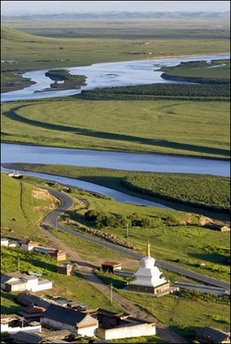Water extraction from the Yellow River is to come under State regulation, to
ensure no sections in the lower reaches of the river dry up.

The Yellow River flows past a Tibetan village
in the southwestern province of Sichuan. China has launched what it said
was its toughest water management program for the Yellow River in a bid to
stem rampant over-exploitation along the nation's second longest waterway.
[AFP/file] |
The government hopes the arrangement will allow China's second longest
waterway to satisfy consumer and commercial demand, without the water level
falling too low.
The government also plans to divert water from the Yangtze, the country's
longest river, to support industrial and agricultural growth in parched
northwestern parts of China.
The new plans were unveiled yesterday by Li Guoying, chief of the Yellow
River Conservancy Committee under the Ministry of Water Resources, marking the
implementation of a State Council ordinance to regulate and control the water
level of the Yellow River.
The ordinance is the first of its kind regulating water use for China's
biggest rivers, Li told a news briefing held by the State Council Information
Office in Beijing.
"The statute guarantees we will make sure the lower reaches of the Yellow
River will not dry up in the future," said Li.
For nearly three decades the mighty river has often slowed to a trickle, even
drying up on some occasions, before it reaches areas such as Shandong Province
in East China.
The low water level is mostly caused by a drastic increase in water demand in
the river's upper and middle reaches, plus a lack of regulations regarding the
allocation and adequate use of river water.
Parts of the river were dry 21 times between 1972 and 1999, with a "serious
impact" on economic and social development in the lower reaches of the river,
according to Li.
But since 1999 the river has not run dry, thanks partly to a system under
which local government chiefs have been held responsible for the use of water
diverted from the river.
In addition, a set of catchments has been built along the river and companies
have been encouraged to invest in leak-proof irrigation channels for farmers,
said Li.
He said the new ordinance builds on these experiences, with a view to easing
stresses and strains in the water supply, and promoting ecological and
environmental conservation.
As China unfolds its western development programme, more and more industrial
projects will be launched, making water need a thorny issue, Li conceded.
The western route of the massive South-North Water Transfer Project is one
solution, he said.
The ambitious water diversion project was initiated in 2002, and should one
day carry 44.8 billion cubic metres of water annually from the Yangtze through
eastern, middle and western routes to water-scarce north.
The eastern and middle routes are under construction, and are expected to
cost 200 billion yuan (US$25 billion) to complete, Li said, adding that both
routes would pass through tunnels beneath the Yellow River and thus will not
cause water shrinkage problems to the river.
Water diverted through the middle route could reach Beijing by 2008, he said.
As for the western route, there is no timetable for when construction will
start, but Li said it will be built in three stages and estimated it would cost
at least 300 billion yuan (US$37.5 billion).
"When the economic and social development of the northwest reaches a certain
level and the potential of water saving measures is exhausted, this (Western
Route of the South-North) project will be launched," he said.
(China Daily 08/02/2006 page1)